Mark Sisson's Blog, page 296
June 19, 2014
Is the Technology in Your Life Working for You or Against You?
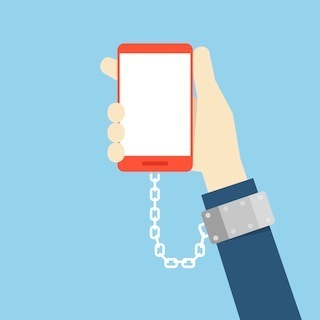 Some weeks ago, I shared some thoughts on the power of food marketing. I claimed its messages and images are so carefully crafted to pique our interests and to influence our associations with certain foods that none of us (who are exposed) are entirely immune. I’ve been thinking lately about the larger applicability of this media principle and how it fits the realm of technology. The fact is, we live in an interesting age held in novel tension between in-person reality and technological representation. We see and experience “regular,” real-time living, and then we also regularly intake a selected, stylized version of just about everything associated with life – personal leisure, family doings, food selections, home appearances, relationship depictions, global events, etc. through our technological devices. The whole experiment is unprecedented in human psychology, yet it’s clear we’re drawn in – often further than we’d ever anticipate. Media forms and the status-bearing tools we use to access them claim an increasing and at times problematic place in our lives.
Some weeks ago, I shared some thoughts on the power of food marketing. I claimed its messages and images are so carefully crafted to pique our interests and to influence our associations with certain foods that none of us (who are exposed) are entirely immune. I’ve been thinking lately about the larger applicability of this media principle and how it fits the realm of technology. The fact is, we live in an interesting age held in novel tension between in-person reality and technological representation. We see and experience “regular,” real-time living, and then we also regularly intake a selected, stylized version of just about everything associated with life – personal leisure, family doings, food selections, home appearances, relationship depictions, global events, etc. through our technological devices. The whole experiment is unprecedented in human psychology, yet it’s clear we’re drawn in – often further than we’d ever anticipate. Media forms and the status-bearing tools we use to access them claim an increasing and at times problematic place in our lives.
We cutting-edge moderns live with the same 24-hour day confines and same human physiology that requires genetically expected “nuisances” like sleep, sun, solitude, and face-to-face socialization as our Paleolithic ancestors did. Yet, at any given moment today’s generations have “the world” at their fingertips – an infinity of digital information and entertainment we’re told we must know or “must see” or must update. How – I venture many of us ask at some point – do people maintain these multiple “exo-worlds” (e.g. having seen every episode of the latest popular show, being constantly active on Facebook and other social media, mastering online games) in addition to living their own physical lives? The truth is, we all live on a moving continuum of choices. Likewise, we all live with technology. How much we live in (or even for) it, however, varies. Do we make it work for us as tool, or do we become its unwitting subject? At what point does technology (particularly media) use morph into overuse or abuse? Can it move from misuse to addiction? What does all this mean for a thoughtful Primal life?
While experts agree that technology addiction is clearly a growing problem, hard statistics are sketchy. Dr. Kimberly Young, author of Caught in the Net, proposes that approximately 12% of Americans show signs of “problematic” Internet use, for example, while the numbers can climb to 30% in parts of Asia, where Internet addiction is considered a greater problem. Part of the difficulty in pinning down the prevalence is the breadth of issues under the tech umbrella and the relatively recent development/general accessibility of many of these technologies. Internet addiction, for example, wasn’t included in the DSM-V (the 5th and recently updated version of the Diagnostic and Statistical Manual of Mental Disorders), although online gaming addiction (generally considered a subset of Internet addiction, which itself is part of the larger label of technology addiction) was listed as a condition warranting further study and consideration.
In the absence of agreement on a clear-cut “addiction” definition, many experts prefer to talk in terms of compulsive or pathological use. Mental health professionals note that those with serious pathological use show signs of addiction, including withdrawal. The compulsion can be so strong that it significantly interferences with or takes over subject’s lives as they give up food, sleep and socialization to continue their time with their technology – whether it’s to play online games, view pornography, compulsively browse the Internet or specific social media. Researchers have noted abnormalities in the gray matter of those who use the Internet compulsively.
Some argue it’s a question of focus. We can’t be addicted to the Internet itself but perhaps can be to a kind of content/engagement found on it (e.g. gaming, pornography, gambling, shopping, social media). It’s a reasonable perspective. That said, there’s something compelling beyond a category of content that seems to have a hold on us. A University of Maryland study found that 80% of young adults, for example, experienced physical withdrawal symptoms similar to those of drug addicts (e.g. cravings, heart palpitations, anxiety attacks) when asked to go without their phones for a day. Another Time Magazine international survey showed that nearly 85% of adults couldn’t go for a day without access to our phones.
Yet, it’s not simply the presence of our devices but our perhaps collectively compulsive use of them that surprises. According to a Mobile Mindset Study done by the security app company Lookout, nearly 60% of us look at our phones at least once an hour. For those of us in the youngest group (18-34), that number jumps to almost 70%. Nearly three-quarters of us would be panicked if we lost our phones. More than half of us look at our phones in bed. Almost 40% of us check it while we’re on the toilet, more than a third of us use it while eating a meal with other people, and a quarter of us look at it while driving. While Lookout’s survey can’t claim the scientific gold standard, I have a hunch these ring pretty true. (What do you think?) If this picture doesn’t reflect a collective obsession, I’m not sure what would.
While I clearly conceptualize the difference between the use of technology and addiction to it, I’d also argue that there’s reason to question just how hazy the line has become between what we’re willing to constitute as “normal” versus abnormal use. We see the words technology addiction or Internet addiction and want to discount the whole premise or simply pin it on “those” people who must have other problems. (Indeed, research does suggest that those who qualify as Internet addicts, for example, do tend to have co-occurring conditions.)
Still, I’m going to rock the boat and question whether we can all fall prey to or require active vigilance against the addictive pull of technology. Just as food packaging and store design is set up to hook us, the lure of websites, games and social media show much more sophisticated strategy. Are we perhaps – with our relatively simple and predictable reward centers – playing with fire when we push the envelope online? We might convince ourselves we’re in control, but how many conversations with our kids got derailed or distracted because of something on our phones? How many nights did have we stayed up later than we wanted because we got sucked into online this or that?
Even if we’re not giving up sleep and sustenance, the fact is we may be compromising other elements of daily life. As many experts have noted in the last decade, technology is transforming even our intimate communication – and not necessarily for the better. In her book Alone Together: Why We Expect More from Technology and Less from Each Other, Sherry Turkle critiques the dampening of personal connection and intimacy with the reliance on technological means of communication and entertainment. When our devices become our sources for leisure and contact, we inevitably deprive ourselves of deeper – more Primal – layers of rapport and attachment. Likewise, we may compromise other elements of health and self-care because of our technological time-sucks. What would our schedules and daily rhythms look like if we did without non-work-essential tech use (during our set work hours)? How much does it take before an indulgence turns into a pattern or at least something that takes too much time and energy to get over to be worth it?
The truth is, we inevitably give up a portion of “real-time” life when we venture to the technological plane of existence however many dozen times per day. Add to that the cognitive “transition” time when we bring ourselves back into the physical present after getting absorbed in our tech tools. No wonder so many of us get that fried, jangly feeling by the end of each day. It’s one wide expanse maybe worth leaving most days between the peace of the simple present and the overstimulation of a virtual world at our fingertips.
Thanks for reading today, everybody. What thoughts would you add about the use and abuse of technology in our culture? What choices do you make? What boundaries do you use for yourself and your kids? Have a great end to the week.
Get the 7-Day Course on the Primal Blueprint Fundamentals for Lifelong Health Delivered to Your Inbox for FREE




June 18, 2014
Have You Had a Breakthrough Workout Lately?
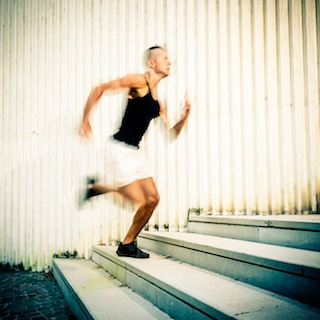 Yesterday, we discussed the importance of finding immediate value in your workouts. This makes exercise more enjoyable and more effective, and it also makes us more likely to want to do it. When we find intrinsic value in our workouts as they’re happening, exercise stops being a chore that we have to do to achieve some far off-goal, like lose weight or stave off disease or live longer. It becomes a meaningful, even pleasurable activity with instant returns. All you have to do is find a way to reframe your workouts. Many people reframe their workouts by turning them into games, working out with a group, focusing on the physical sensations of training, or taking them outdoors to enjoy the nature setting. Those are great ways to do it, but there’s another method: the breakthrough workout.
Yesterday, we discussed the importance of finding immediate value in your workouts. This makes exercise more enjoyable and more effective, and it also makes us more likely to want to do it. When we find intrinsic value in our workouts as they’re happening, exercise stops being a chore that we have to do to achieve some far off-goal, like lose weight or stave off disease or live longer. It becomes a meaningful, even pleasurable activity with instant returns. All you have to do is find a way to reframe your workouts. Many people reframe their workouts by turning them into games, working out with a group, focusing on the physical sensations of training, or taking them outdoors to enjoy the nature setting. Those are great ways to do it, but there’s another method: the breakthrough workout.
Everyone knows that improving one’s fitness requires sustained, consistent, progressive training. You can’t do a heroic workout every couple of weeks or months and hope to make a big difference. This doesn’t mean that our bodies “wait” until you’ve logged a week or two of steady exercise to start adapting to the exercise, though. The adaptation to training begins immediately after a single bout of exercise. String enough of them together, and you get the adaptations that we know, love, and want: bigger, stronger muscles; body fat loss; improved cardiovascular fitness; and better overall athleticism. Consistent workouts are necessary because you get the cumulative effects of adaptations to those individual workouts.
This means, of course, that one workout alone isn’t enough, but it also means that those individual extraordinary efforts can elicit incredible results when laid on top of a consistent training schedule. I call these breakthrough workouts.
When I was a triathlete, I gained more fitness benefit from a single 100-mile ride in the mountains than perhaps ten rides of 20 or 30 miles pedaling along flat terrain. That ride pushed my limits and forced me to draw deep from the well of human performance, and I got more fit after recovering from it. The workout immediately after it was easier than the one preceding it. But here’s the thing: both the 100-mile mountain climb and the routine 20-30 milers were necessary. If I wasn’t working from the base provided by the easier rides, the breakthrough workout wouldn’t have done much for me. And if I tried to switch things around by stringing together a bunch of 100-mile mountain climbs, I wouldn’t be able to recover quickly enough to do them regularly.
A breakthrough workout is one that is difficult and challenging enough to stimulate a fitness breakthrough. They come in assorted forms depending on one’s fitness goals. An endurance athlete can have a breakthrough workout of running or cycling longer than they ever have before. Or, if an endurance athlete is used to clicking along the miles at aerobic pace, a high intensity interval session can qualify as a breakthrough workout. Anything that’s an extraordinary effort. Anything that requires you to do something you’ve never done before.
Consequently, other workouts are then categorized as “break even” workouts or “recovery” workouts. Break even workouts are your typical session that helps to support/preserve current fitness level. This is the base work. A recovery workout is one that is easier in perceived effort than a baseline effort and used specifically to get the body moving and blood flowing to promote recovery and healing without getting stiff.
Way back in 1988, when I coined the phrase “breakthrough workouts” in my book Training and Racing Duathlons, my primary focus was endurance training. And though the notion of the breakthrough workout originated in the context of my endurance training, it can still be applied to other types of exercise.
Take your average strength trainee using barbells and following a basic linear progression. LP is perfect way for beginners. You’re consistently getting stronger and hitting PRs every single workout. It’s empowering while it lasts. But you can’t add five pounds to the bar forever. Once that stops and you hit a sticking point, it’s time to introduce breakthrough workouts. Maybe instead of sticking to the standard 3 sets of 5 reps in the back squat, you do an unbroken 20 rep set with a reasonably heavy weight once a week.
Even a casual fitness enthusiast should design their exercise program with a sensible balance of stress and rest. Going out and doing the same thing every day, such as walking 2 miles at a steady pace or going thru a sequence of 8 machines at the gym for 12 reps each is certainly better than sitting at home on the couch and provides a great activity base, but after a while the body will adapt to a rote regimen and fitness progress will stall. We need to push the boundaries to get anywhere.
In some cases, a “consistent” exercise strategy can even trend the exerciser into a chronic pattern, even for a relatively casual fitness enthusiast. For example, taking a couple spin classes each week, doing a weight circuit another day, and doing a weekend play effort sounds like a sensible approach, but on certain weeks or months the body can become overstressed and fail to benefit from one’s “regular” routine. It’s better to challenge the body occasionally with breakthrough efforts – huge acute stressors that you then recover from.
What does this mean for you? Why are they so helpful?
There are the physiological changes, to start. There are no studies specifically examining breakthrough workouts, but there is a ton of literature showing how adaptation to acute training sessions begins immediately after just one workout:
Blood markers of endogenous antioxidant defenses against oxidative stress up-regulate immediately following a workout.
Your memory improves and your brain becomes more plastic.
Motor memory (the ability to acquire a new motor skill) also increases.
MTOR1C (the “anabolic pathway” responsible for muscle hypertrophy) activates and growth hormone increases in response to a single bout of resistance training.
An acute session of strength training lowers expression of myostatin, a “negative regulator” of muscle size (meaning lower levels of myostatin increase muscle hypertrophy).
Skeletal muscle mitochondrial biogenesis begins immediately after a single session of high intensity interval training.
Blood pressure is decreased in type 2 diabetics after a single strength training session.
In other words, one workout – the right kind of workout – can trigger muscle hypertrophy, improve the ability of your muscles to burn energy substrates (mitochondrial biogenesis), increase skill development, and modulate the inflammatory and hypertensive response to stressors. Is it enough? No; you have to stick with it. But it’s a good start and a real kick in the pants.
What’s more, fluctuating stress and rest exercise patterns allows for better recovery as the exerciser is free from the compulsion of sticking to a consistent schedule in order to preserve fitness. You can skip a workout if you need to rest and recover.
And that’s how a breakthrough workout works physiologically – by giving a big, exaggerated boost to those very same adaptive processes that regular workouts kickstart along with enough space to recover and progress.
There are also less tangible, more mental benefits to breakthrough workouts:
Remember, although being the smartest apes around is pretty great and all, it gets us into trouble. We overthink everything. That’s led us to discover quantum mechanics, learn how to navigate using the stars, and wield all the world’s knowledge in a small device that fits in the palm of our hand, but it also means we can psyche ourselves out and lose before anything even starts.
Undertaking and successfully completing a breakthrough workout more intense and tougher than any before it provides a huge psychological boost that can’t be denied. You’ve overcome a formidable challenge. You have incontrovertible proof that you can get it done. You realize you have what it takes, and it becomes a lot easier to access it in the future. Don’t underestimate the value of the confidence these workouts can provide.
Breakthrough workouts also free you from the “must work out every day or feel like a useless slob whose chest muscles are shrinking by the minute” mentality. When you know you can go hard once or twice a week, take it relatively easy the remaining days, and still see progress, you won’t beat yourself up over missing a day or two in the gym. Life gets in the way, it always does, and as long as you don’t languish for weeks and months on end, you can improve your fitness by kicking ass once or twice a week.
There are limitations and requirements and guidelines, of course. Breakthrough workouts aren’t magic.
Breakthrough workouts only work if you’re already training consistently. Doing nothing for weeks only to come out swinging with a PR deadlift attempt or a century ride won’t do much for you besides leave you sore and possibly injured. You have to have something – a plateau, a rut, a slow and steady incline – to break through.
Breakthrough workouts represent extraordinary efforts. I mean it. Adding five pounds to your barbell squat from last week represents a progressive overload, but it’s not a breakthrough. Adding an extra mile to your regular jog isn’t exactly a breakthrough; turning your flat easy jog into a breakneck uphill climb is a breakthrough workout.
Most breakthrough workouts are planned endeavors. Planning it out ensures you can get enough rest before and sufficiently recover after. You’re going to need both. If you go into a breakthrough workout insufficiently rested, it’s no longer a breakthrough. You’ll probably fall short and the added stress of poor recovery will hamper the results you get.
Some breakthrough workouts are spontaneous affairs. While these days I always plan my hardest workouts ahead of time, there are those days where I wake up and feel different. There’s an extra spring in my step as I get out of bed, a bit more dopamine than usual surges across my synapses in response to my morning coffee and everything shines with optimism. My joints feel great, my tissues are rested, my muscles are primed, I’m mentally ready, things just feel right. On these days, whatever I end up doing turns into a breakthrough workout. I’ll end up hiking a 15 mile loop (and sprinting up the occasional switchback!) when I’d originally planned on just a 4 or 5-miler, for example.
I’m sure you’ve experienced the same. Where you run a few more intervals than you’d planned on, bust out twelve reps in the last set instead of five, continue on to the summit instead of turning back halfway there. Where you do something you’ve never done before and surprise yourself.
What do you think, readers? When was the last time you had a breakthrough workout? What were the effects? Were they lasting?
Let’s hear about your most memorable, hardest and ultimately rewarding workout sessions in the comment section. Thanks for reading!
This Week Only: Get the All-New Digital Primal Blueprint 90-Day Journal Plus 35 Other eBooks for Just 37 Bucks




June 17, 2014
Do Your Workouts Feel Like a Chore?
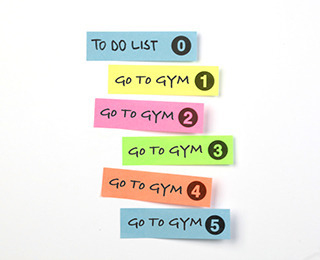 Evolution tends to reinforce healthy, beneficial behaviors that improve the survival of members of a species by making them enjoyable. Sex, sleep, socializing, and animal fat either feel good, taste good, and sometimes feel and taste good at the same time not “just because” but because they are necessary components of a healthy, (re)productive lifestyle. And it’s not just the act that feels good. Evolution has also reinforced the anticipation of the behavior. At the prospect of sex, we become aroused, horny, randy, or whatever you want to call the pleasure of anticipation. Those long, delicious yawns that herald the surge of melatonin and promise excellent sleep as we slip beneath the cool covers with a good book? Nothing better. And I still get happy stomach butterflies when friends are coming for dinner and the scent of crackling pork skins fills the kitchen.
Evolution tends to reinforce healthy, beneficial behaviors that improve the survival of members of a species by making them enjoyable. Sex, sleep, socializing, and animal fat either feel good, taste good, and sometimes feel and taste good at the same time not “just because” but because they are necessary components of a healthy, (re)productive lifestyle. And it’s not just the act that feels good. Evolution has also reinforced the anticipation of the behavior. At the prospect of sex, we become aroused, horny, randy, or whatever you want to call the pleasure of anticipation. Those long, delicious yawns that herald the surge of melatonin and promise excellent sleep as we slip beneath the cool covers with a good book? Nothing better. And I still get happy stomach butterflies when friends are coming for dinner and the scent of crackling pork skins fills the kitchen.
Okay, but what about exercise? There’s the endorphin and endocannabinoid high from exercising intensely, but that exists to keep us moving during an activity as we near the physiological breaking point. It doesn’t get us off our butts in the first place. If exercise is so good for us – and it is – why doesn’t everyone crave it? Why does it feel like a chore? Why do many people dread it so much?
Here’s the thing: exercise wasn’t always optional. If we didn’t chase down the antelope, we wouldn’t have dinner. If we didn’t climb that forty foot acacia tree, our glycogen-starved muscles wouldn’t get the honey. If we didn’t make the six mile walk to the spring, we wouldn’t have water to drink. We had to do these “exercises” if we wanted to survive on a day-to-day basis. There was no “Oh, I’ll just sit on this couch and eat microwaved pot pies and go to the gym some other time.” There was no selective pressure to evolve a love of exercise because we were gonna do it anyway.
Today, exercise is in a weird place. Exercise is optional, but it’s also not. Though being sedentary remains disastrous to our health, circumstance no longer compels us to move. There’s no trench-coated goon pointing a gun at us and nodding toward the treadmill, but plenty of “authorities” point their fingers and strongly recommend exercise on pain of disease. We’re buried in studies proclaiming the essentiality of exercise for good health. The message is clear and overwhelming: we’d better work out if we want to be healthy and live long. Just like they tell us we need to work the crappy soul-sucking job to pay the bills, they tell us we need to exercise for thirty minutes a day to stave off disease. For most people living in the first world…
Exercise is something you do to lose weight. It’s a mechanistic way to churn through the calories you’ve eaten and make room for the calories you want to eat.
Exercise is something you do even though it’s unpleasant. It’s like brushing your teeth, taking out the trash, and emptying the cat litter.
Exercise is about attaining a far-off goal.
Meanwhile, the journey – the actual experience of exercising, of moving your body through space and time, of challenging your physical capabilities – is forgotten. It’s not just forgotten, it’s willfully ignored. We actually try to shut it out, because the act of exercising is all pain and suffering and drudgery. It’s the goal that matters to us, the weight lost, the weight lifted, the miles logged, the calories burned, the beach body attained, the tickets to the gun show redeemed.
The evidence suggests that this paradigm doesn’t work all that well. A series of three recent studies illustrates this. In the first, researchers gave healthy adult women (most of them overweight) a map of a mile-long outdoor walking course and told them to walk it for half an hour. Half were told to treat the walk as exercise and monitor their exertion, half were told to enjoy the walk and listen to music. Both groups spent the same 30 minutes walking the same course, but only the exercising group felt grumpy and fatigued. And when they had lunch, the group who’d “exercised” consistently chose soda over water, pudding over applesauce, and ate far more calories than the “fun” group.
The second study placed a group of men on the same mile loop. Half “exercised,” half walked for fun. After the walk, they were given plastic baggies, access to an unlimited bowl of M&Ms, and instructions to fill the bags with as many as they desired. The exercise group filled their bags with twice as much candy as the fun group.
Finally, the researchers approached runners as they finished a relay marathon race and offered them a choice of snacks: a gooey chocolate bar or a “healthy” granola bar. Those who said the race had been difficult and unpleasant were more likely to choose the chocolate, while those who’d enjoyed the race usually chose the granola bar.
When working out feels like a chore, we demand compensation upon completion, often in the form of junk food. This can derail weight loss efforts, but it also perpetuates an abusive relationship with physical activity. There’s also evidence, at least in non-human animals, that voluntary exercise is less stressful than involuntary or forced exercise. If that’s the case, workouts that feel like chores heap additional systemic stress on top of the local stress the exercise already applies to the muscles. This could make it harder to recover from exercise and easier to recover from play – even if the total work done for each was identical.
How do we change our relationship with physical activity? How can we reframe exercise to make it less unpleasant and more effective? How can we train ourselves to appreciate the journey of movement?
Reframing our own activities and appreciating movement for movement’s sake can be tough. You won’t have a guy in a white coat wielding a clipboard and considerable amounts of authority telling you to “enjoy the walk” you’re about to take like the people in the studies.
You can’t expect to make everything fun and games. Few people think of hill sprints as “fun.” I can’t ever recall seeing a powerlifter rock a Cheshire grin in the power cage. But it has to be rewarding. You have to get something from it immediately. The activity must be its own compensation. The key, I think, is finding immediate value in the activity rather than relying on some far off goal, like weight loss, to motivate you. The weight loss, the hypertrophy, the fitness gains, all those “bigger” goals will happen anyway, but they’re not enough of a primary motivator for most people. I mean, everyone has those goals. They’re the reason most people decide they need to start exercising and why there are over 50 million gym memberships in this country. But by and large, they’re not reaching those goals. Something’s gotta give.
That’s easier said than done. Undoing a lifetime of acculturation isn’t easy. You have to willingly appreciate the flowers along the sidewalk, the birds in the trees above, the sunlight shining down, the refreshing sensations of unused muscles finally used. You have to realize that our bodies are built to move and need to move. We’ve got these shoulders that rotate almost 360 degrees. We can draw our knees up to our chins and touch our toes with straight legs and do the splits (in theory). It’s a crime not to use them – and you have to feel that. You have to find something of worth in the exercise as you’re doing it.
That could be a PR in the squat, or discovering that sprinting up the steep hill outside your place is getting a lot easier. It could be the the perfect high-five shared with a CrossFit bro after Fran that seems to make time stop and the universe shudder for a moment. Or maybe it’s the meditative flow state you reach when training, the peace of hiking through an ancient redwood forest, or chatting with your power-walking partner. It can also be the sheer joy we feel doing something we love to do, like play Ultimate Frisbee (winning doesn’t hurt).
It took me a long time to reach that place, but I wouldn’t trade it for anything. I suggest you try to do the same.
Like This Blog Post? Dig Deeper with Primal Blueprint Books and Learn How You Can Reprogram Your Genes to Become Leaner, Stronger and Healthier




June 16, 2014
Dear Mark: Exercise and Gut Diversity; Pregnancy and Calories
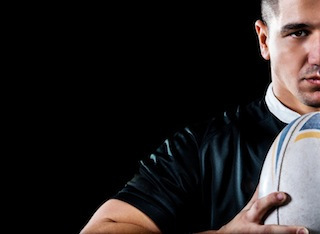 For today’s edition of Dear Mark, we’ve got a two-parter. First up is a discussion of the latest (and only) exercise and gut flora study. It’s been making the rounds and even I gave it a brief mention in yesterday’s Link Love, but today I dig a little deeper. Find out what we can take away from it and apply to our own lives. Then, I cover a series of several questions regarding pregnancy, calories, weight gain, and exercise from a newly pregnant mother-to-be. Even though I’m a man, I offer my perspective and insight.
For today’s edition of Dear Mark, we’ve got a two-parter. First up is a discussion of the latest (and only) exercise and gut flora study. It’s been making the rounds and even I gave it a brief mention in yesterday’s Link Love, but today I dig a little deeper. Find out what we can take away from it and apply to our own lives. Then, I cover a series of several questions regarding pregnancy, calories, weight gain, and exercise from a newly pregnant mother-to-be. Even though I’m a man, I offer my perspective and insight.
Let’s go:
Hey Mark,
What do you think about that new gut flora/exercise study that suggests that gut bacteria diversity improves with exercise?
Erik
It’s a great study, and the first of its kind in humans. A study in rats had previously shown that exercise has beneficial effects on gut health, with rats who engage in voluntary running on a rat wheel producing more colonic butyrate (the beneficial short chain fatty acid produced by prebiotic fermentation) than sedentary rats. For this one, the authors examined a group of professional rugby players from Ireland engaged in preseason training, along with two control groups – a normal weight (BMI <25.5) group and an overweight (BMI >28) group – to see how exercise (or a lack thereof) would affect gut microbial diversity. Gut microbial diversity is generally seen as a Good Thing. Higher diversity is associated with less obesity and overweight, better inflammatory profiles, improved immune responses, and a lower incidence of several diseases, including autism, inflammatory disorders, and gastrointestinal disease.
By now, chronic stress is widely accepted as having a negative impact on gut health. Exercise is a stressor, with more intense exercise being more stressful, so you’d think a group of professional athletes in a rigorous training camp might have suboptimal microbial diversity in their guts. But the opposite was true. Despite their huge exercise load, rugby athletes had far more microbial diversity in their guts than either of the control groups. They also had less inflammation and better metabolic markers.
What gives? How were they able to withstand all the exercise?
This study examined professional rugby players during preseason training, and I think that’s a salient variable. Preseason is less grueling than the season. There’s more strength training, more regimented rest periods, and more overall control of the schedule. They’re going hard, no doubt, and the actual training that occurs in the preseason is more intense than the regular season, but it’s more measured and predictable since they’re not juggling training with playing matches. They’re not just killing themselves on a daily basis with neither rhyme nor reason. Pro rugby players are treated very well. Coaches and trainers tailor individual training and recovery programs to their strengths and weaknesses. Dietitians build them diet plans. These aren’t amateurs holding down day jobs and destroying their bodies with excessive high intensity exercise in their free time. These aren’t Ironman hopefuls training four hours a day. They’re big, solid dudes walking around with low body fat, high lean mass (BMIs in the realm of 29 with 16% body fat, according to the study), eating good food, recovering well, getting massages, doing yoga, taking days off when they need them, and monitoring their progress/adherence with regular checkups. Their lives are dedicated to training and recovery. That makes a huge difference.
There were other differences that probably impacted microbial diversity:
Athletes ate more fruits and vegetables, a good source of fermentable fibers that promote microbial diversity. If you starve your gut bugs, they won’t diversify.
They ate way more protein than the other groups, and dietary protein was strongly associated with increased microbial diversity. Remember the study from a few months back showing that a zero-carb, zero-plant, all-meat and cheese diet resulted in “unhealthy” gut flora? Remember how people took that to mean this Primal stuff was a recipe for microbial disaster? I guess if you eat plenty of meat with plenty of fruits and vegetables – you know, like a normal person following a standard Primal way of eating – your gut bugs do okay. Better than okay, even.
They also snacked less than controls. Snack food is typically awful stuff, processed and full of industrial, gut-starving ingredients. I suspect that grazing all day doesn’t help, either. Eat solid meals, let your gut bugs go a little hungry in between feedings. They need to be fed, but they probably don’t need a steady, endless trickle of food. Some gut bugs often eat the byproducts created by other gut bugs upon fermentation of fiber.
To determine whether this study means anything for you, ask yourself a few questions. Is your training improving your life and health? Are you recovering from your workouts? Are you progressing? How’s your gut function? Are digestion and elimination going well, as far as you can tell? By and large, most people engaged in regular exercise experience improved gut function. If you can answer those questions in the affirmative, it’s a safe bet that your training is having a positive effect on your gut.
If you can’t dedicate your life to training and recovery, your gut probably can’t get away with a pro-rugby player’s level of activity. That said, your gut definitely can’t get away with being sedentary.
Hi Mark…..
I just found out that I’m pregnant and I really want to stick to primal eating during the whole 9 months. So far so good, but I would like to know what would be an ideal weight gain. Should I consider an extra intake of calories or should I eat intuitively?
Is it safe to hit the sweet spot?, fast 12-14hours in this stage? What about sprinting?
Sorry for so many questions but I really want to manage weight….I’ve seen too many friends gaining so much weight that after delivery over a year they are totally out of shape……
Thanks for sharing your knowledge,
Sofia
Congratulations, first of all. Let’s address your questions one by one.
Calorie intake/weight: Eat when hungry. Sometimes your appetite will be non-existent. Other times you’ll be insatiable. Just go with the flow, and if that means you eat an “extra” 1000 calories one day and half that the next, it’s going to be okay. There’s a difference between nausea and lack of hunger, though. If you find yourself not eating much for a stretch of days because nothing sounds appetizing – but you’re still hungry - then you should make a point to eat something.
Try not to stress about the weight. I know, I know, it’s easier said than done. But “managing” your weight during pregnancy just turns the whole endeavor into a big chore. And from what I gather, pregnancy in and of itself isn’t the easiest thing in the world. Don’t add the stress of counting the calories you’re eating, fretting over the entire pineapple you just devoured, beating yourself up because you’re just too tired to exercise tonight, or worrying how stubbornly the weight will stick around after you’ve given birth.
Fasting: Eh. It might be safe, but I really wouldn’t risk it. You probably shouldn’t be trying to lose weight or diet down when pregnant. Your body is all about nurturing that baby growing inside you, despite what you might prefer. These days, we emphasize the primacy of the mother’s (and father’s to a lesser degree) desires. She’s the boss, she makes the decisions. If she wants to lose weight, she can do it because it’s her choice. But your choices may very well butt heads with your physiological directive. I’m not saying you can’t try to lose weight. You can. Go ahead. Just don’t be surprised when your body resists the weight loss and you start feeling “off.” We are baby-making machines (both men and women) as far as our base physiology is concerned. It’s a tough situation.
Sprinting: Sure, as long as it’s comfortable. First trimester should be fine. Don’t sprint if you feel the baby bouncing around in there. Make your sprints shorter than you normally would, like 5-10 seconds each with plenty of rest. Try not to turn it into a sprawled-out-on-the-floor-gasping-for-breath situation, because that indicates you’re really depleting your precious energy substrates. Keep ‘em short and hard with lots of rest and you won’t be stressing your body out too much. Cycle (bump permitting) or swimming sprints are a good option if running doesn’t work.
Just keep moving as much as possible. When sprinting and heavy lifting and the more intense stuff get unfeasible, don’t stop walking every day. Do what you can, and make the daily activity a habit. And continue the habit after the kid arrives. I think a lot of women (and men) get overwhelmed with the immensity of parenthood and fall out of their activity habits – if they even had them to begin with. When you’re stumbling through the dreamy haze of the first few weeks, sitting on a comfy couch in front of the TV is far more attractive to your sleep-deprived brain than going for an afternoon walk. You shouldn’t expect to keep up at CrossFit as brand new parents tag-teaming a newborn, but you can still go for the walk. Do so. It will make a difference.
While we can learn a lot from the anthropological records, pregnancy and birth have never been minor, everyday affairs. The stories of pregnant women walking off into the bush to squat for a few minutes and come back with a healthy, happy, crying baby are nice and all, but I don’t know if they represent the universal birth. There is no universal birth experience. There are many experiences and many stories, and they differ greatly. Realize that women and babies alike died during childbirth. The variable we invoke to counter the common anti-Primal/paleo “cavemen only lived to 30!” talking point cannot be ignored here: infant mortality was high, and it’s possible that fetal malnutrition was a common predisposing factor. The 20-25 pounds modern OBs typically recommend women gain during a pregnancy might be on the higher side of historically/anthropologically normal, but it’s a good, safe buffer for many women on less nutrient-dense diets than Primal. It’s better to overshoot than undershoot when it comes to growing and sustaining a human.
I’ll see if Carrie has any other advice for next week or the following one. After all, she’s been there.
Thanks for reading, everyone. Let me know what you think in the comments!
Like This Blog Post? Dig Deeper with Primal Blueprint Books and Learn How You Can Reprogram Your Genes to Become Leaner, Stronger and Healthier




June 15, 2014
Weekend Link Love
 Forget standing workstations. The new ergonomics movement sweeping the startup world is the fetal position workstation. Kidding aside, the typical sedentary office environment is a serious public health problem, and we’re tackling it head on. I’m working with biomechanist and popular author Katy Bowman on a comprehensive multimedia course called Don’t Just Sit There!. Stay tuned for more on that in the near future.
Forget standing workstations. The new ergonomics movement sweeping the startup world is the fetal position workstation. Kidding aside, the typical sedentary office environment is a serious public health problem, and we’re tackling it head on. I’m working with biomechanist and popular author Katy Bowman on a comprehensive multimedia course called Don’t Just Sit There!. Stay tuned for more on that in the near future.
I was recently on the Low Carb Paleo Show podcast. Go have a listen.
Episode #23 of The Primal Blueprint Podcast is now live. Brad has a lively discussion with Paleo Girl author Leslie Klenke about her background, her story, her new book, and why parents should read it alongside their teens.
Research of the Week
In breast cancer patients whose tumors express IGF-1 receptors, those who limited carb intake experienced less cancer recurrence.
Fasting for three days stimulates stem cell regeneration of the aging immune system.
Exercise is good for your gut flora.
Early hominids may have developed massive jaws not to chew raw grains and other roughage, but to take punches.
Interesting Blog Posts
An excellent guide to diet-based sunburn resistance.
How does athletic performance fare in the keto-adapted?
A few years ago in a post on type 1 diabetes, I mentioned a young Danish boy who’d put his T1D into remission with a gluten-free diet. Three years later, he’s still in remission.
Media, Schmedia
While many researchers recognize the deleterious impact of artificial light on the quality and quantity of our sleep, one scientist isn’t so convinced: “Can’t you people just close your eyes?”
Why cramps actually occur, and how Gatorade probably isn’t helping matters.
Everything Else
A new Kickstarter hopes to open Health Kitchen, the very first (but not last) hospital cafe with gluten-free and paleo-friendly options. It looks like a great cause to me.
Looks like the “3500 calories = a pound of body fat” law is more of a canard.
It looked like the FDA was about to ban traditionally-aged artisan cheeses. They’ve since walked back their statements, but the threat remains.
A pill that detects pesticides in your drinking water.
Take that, crows! Babies finally beat them at something.
Five invasive, incredibly delicious species.
Recipe Corner
Oxtail and romaine lettuce stir fry. Yes, stir-fried lettuce. Weird, but good.
Real shepherd’s pie, potatoes and all.
Time Capsule
One year ago (June 15 – June 21)
How to Take a Better Bath – Optimize your bathing experience.
8 Primal Mantras for Beginners – Keep these words in heart and mind as you begin your Primal journey.
Comment of the Week
Actually, Mark, I was standing and walking about in bare feet during the whole interview with Evan Brand.
- Touché, Aaron!
Get the 7-Day Course on the Primal Blueprint Fundamentals for Lifelong Health Delivered to Your Inbox for FREE




June 14, 2014
Sweet Potato Pasta with Hearty Meat Sauce (No Pasta Needed!)
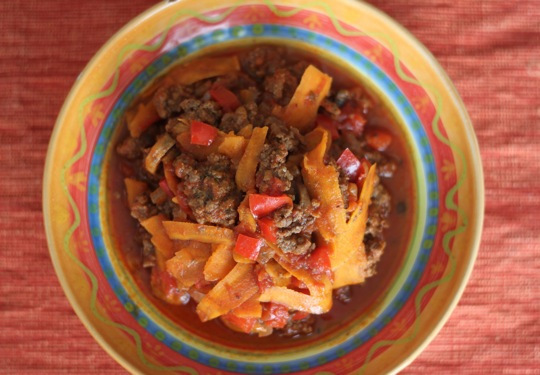 You can never have too many quick and easy meals in your recipe arsenal. If the recipe is family-friendly and likely to please everyone at the table, all the better. If it’s also a one-pot meal that provides all the protein and veggies you need in one sitting, then it’s a real keeper.
You can never have too many quick and easy meals in your recipe arsenal. If the recipe is family-friendly and likely to please everyone at the table, all the better. If it’s also a one-pot meal that provides all the protein and veggies you need in one sitting, then it’s a real keeper.
Sweet Potato Pasta is just this type of meal. High in protein from ground beef, the dish also contains a healthy and dense source of carbs (sweet potato) and a few brightly colored vegetables (tomatoes and bell pepper). Although you could serve this over zucchini or celeriac “noodles” there’s really no need. Just fill your bowl with sweet potato pasta sauce and dig in.
If you’re a fan of sweet potatoes, you’ll love the quick-cooking trick this recipe reveals. Using a vegetable peeler, peel the potato down into thin strips. Stirred into simmering sauce or broth, the potato cooks quickly and evenly. Adding strands of sweet potato to this simple recipe transforms it from good to really, really delicious.
Servings: 2, with leftovers
Time in the Kitchen: 45 minutes
Ingredients:
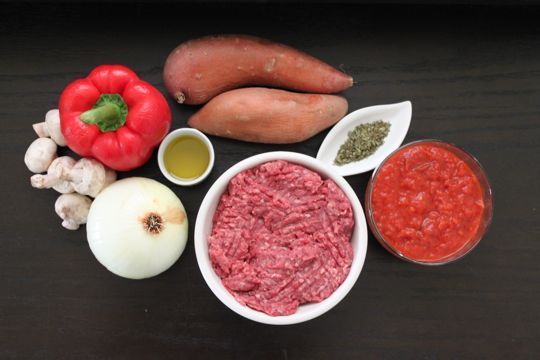
2 tablespoons olive oil (30 ml)
1 onion, finely chopped
1 or more bell peppers, finely chopped
12 white mushrooms, sliced
1 teaspoon dried oregano (5 ml)
1 pound ground beef (450 g)
1 large or 2 smaller sweet potatoes, peeled
24 to 28 ounces (680 g to 795 g) of your favorite pasta sauce (or crushed tomatoes)
Salt and pepper
Fresh herbs for garnish, if desired
Instructions:
In a deep sauté pan or skillet over medium-high heat, warm the olive oil and sauté the onion, bell pepper and mushroom until soft, 5 minutes.
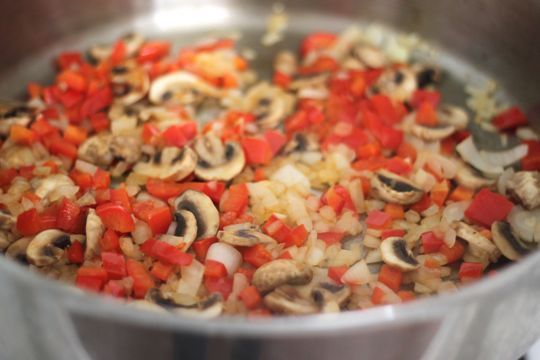
Add the ground beef, season with oregano, salt and pepper. Cook until browned.
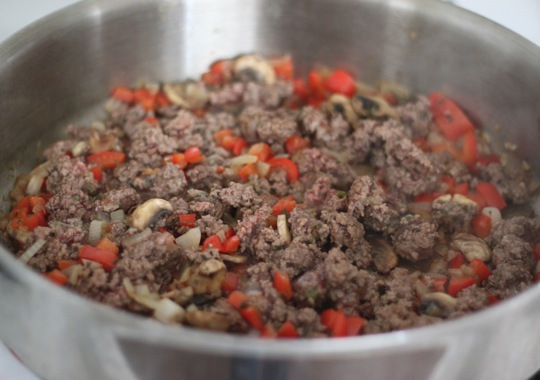
Once the meat is browned, grab the vegetable peeler and peel thin strips of sweet potato into the skillet until you have about 2 large handfuls of strips. Add more sweet potato strips if you prefer.
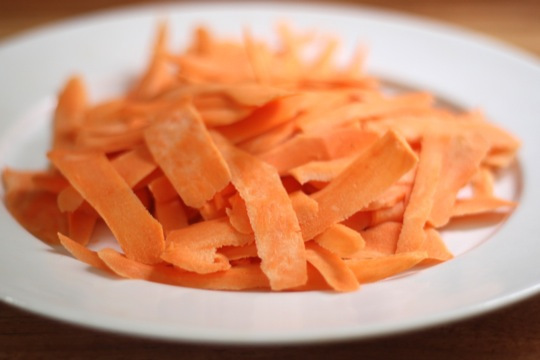
Pour in the tomato sauce. Mix well, turn the heat down slightly. cover and simmer for 15 minutes. If the sauce seems dry while simmering, add a little water.
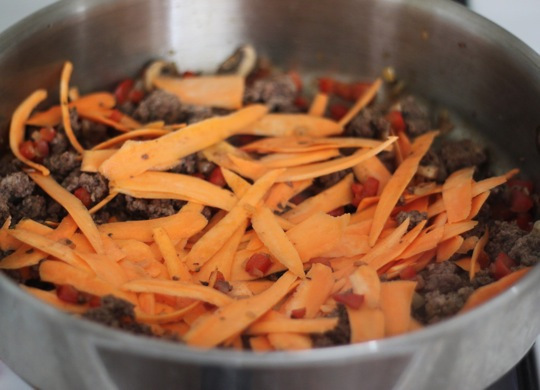
Serve topped with fresh herbs.

Not Sure What to Eat? Get the Primal Blueprint Meal Plan for Shopping Lists and Recipes Delivered Directly to Your Inbox Each Week




June 13, 2014
Paleo Girl: The Evolution of a Yo-Yo Dieter
It’s Friday, everyone! And that means another Primal Blueprint Real Life Story from a Mark’s Daily Apple reader. If you have your own success story and would like to share it with me and the Mark’s Daily Apple community please contact me here. I’ll continue to publish these each Friday as long as they keep coming in. Thank you for reading!
 My story isn’t entirely unique or the most profound physical transformation you’ll ever see; and it’s not strictly a tale of finding the right diet, shedding some pounds, and living happily ever after. In addition to finding my version of wellness, this journey was one of self-discovery, finding purpose, and embracing self-love.
My story isn’t entirely unique or the most profound physical transformation you’ll ever see; and it’s not strictly a tale of finding the right diet, shedding some pounds, and living happily ever after. In addition to finding my version of wellness, this journey was one of self-discovery, finding purpose, and embracing self-love.
When I was in high school, I started my tumultuous affair with yo-yo dieting. I didn’t know the first thing about nutrition and certainly had never considered what my health or fitness goals were—but there I was starving myself, popping diet pills, and hitting the gym. If I really sit and think about it now, I realize I was only going through those motions because I had naively given my high school boyfriend too much control over my life. He was the original yo-yo dieter.
After graduating from high school and surrounding myself with an entirely new social circle, I really got into the party scene. Junk food, alcohol, cigarettes, and staying up until sunrise was my weekend routine—and I was having the time of my life! I felt a real sense of freedom and independence, and for the first time I felt like I could be Leslie. But of course with all the partying, this Leslie character was getting fat.
That’s when I dipped back into my past and started playing the diet game again…except this time, I did so by my rules. For the next decade I followed a 1,200-calorie plan: three meals a day at 300 calories each, and two snacks at 150 calories a pop. I survived solely off of Lean Cuisines, Lean Pockets, Morning Star, Egg Beaters, 100 Calorie Packs, Slim-Fast, Subway, and anything with a low-fat or fat-free label slapped on the front. I could maintain these eating habits for a few weeks on average, then hunger, exhaustion, boredom, lack of instant results, or a social event would send me off the deep end.
When I was 25 years old, I found myself overweight, unfulfilled, disconnected, and restless. Something needed to change—and it did. My boyfriend (now husband) and I packed all of our belongings into a U-Haul and drove our lives out of Ohio and to Los Angeles, California, in search of a new beginning.
I could write a novel about the first few years I spent in LA, but I’ll spare you the details for now and get to the good stuff.
In 2011, I was introduced to Mark’s Daily Apple and The Primal Blueprint. I had never read anything so logical about health and wellness in my life and was eager to share this newly discovered lifestyle with my best friend Liz. Over the previous two years, Liz and I were crash diet buddies…sharing recipes for low fat dishes, being accountability buddies (accountabilibuddies?) when it came to workouts, and we even shared a stint in the hell that is vegetarianism. When I shared the basics of what it meant to be Primal with Liz, she was just as amped as I was, and we started the journey together the following week.
During our first few days as modern-day cave girls, Liz serendipitously came across a job for Primal Nutrition. She applied, had an interview, and found out that week she got the job! Fast-forward to now, and Liz is the Community Outreach Manager at Primal Nutrition and is married to Farhad, her perfect match who just so happened to work at the office too. You might think I’m enhancing this story to make it sound like something out of a movie, but I assure you I’m not. When you’re on the right path in life, I think everything just has a way of coming together.
Speaking of coming together, I’ll get back to my story! Liz invited me to help setup for PrimalCon Oxnard in April of 2013. This was the first time I met Mark Sisson. I shared a bit about myself: that I had been Primal for a couple years, that I was currently an Art Director for a clothing company, and how one day I wanted to write a book or find a way to help young people avoid the misinformation I was faced with about health when I was younger. He thought my message was great, offered me some advice, and then I went back to assembling goodie bags for the event.
Returning from PrimalCon (or “reentry” as some call it) was tough. When you’re immersed with so many likeminded people looking to better themselves and those around them, coming back to the real world can be a total bummer. It was then that I knew I had to make Primal living and helping others my mission.
I decided to write a Primal children’s book and pitch it to Mark. He loved the story and initial illustrations, and asked me to meet with him at the Primal Nutrition offices in Malibu. During the meeting, the conversation shifted. I mentioned that there was an entire demographic between the kid’s book and The Primal Blueprint that we could reach—teenagers. Mark loved this idea, and that night I went home and worked on a pitch for a Primal teen book. This pitch is what later became my first book, Paleo Girl.
I received my book deal the first week of June 2013 and quit my job so that I could solely focus on Paleo Girl. I knew writing a book would be a life changing experience, but I never expected it to be quite like this. In the year it took me to write and design Paleo Girl, I was forced to look at my life and the choices that I had made. You can’t exactly put a lifestyle guide together for teen girls without coming face-to-face with your teenage self.
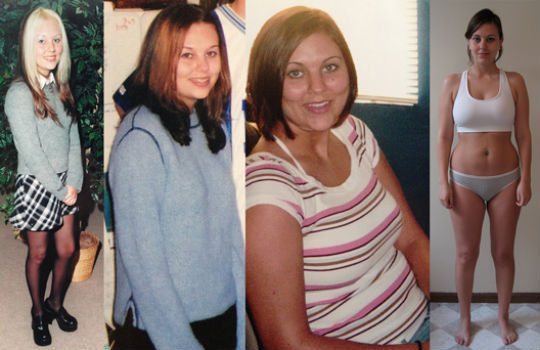
The evolution a a yo-yo dieter. From left to right, Senior year 2001 Homecoming Court (check out that hair!), 115 lbs; December 2002 and a total brace face, 130 lbs; June 2005 (horizontal stripes were not my friend), 142 lbs; May 2006 after months of calorie-restricted dieting (can you see how tired I am?) 125 lbs.
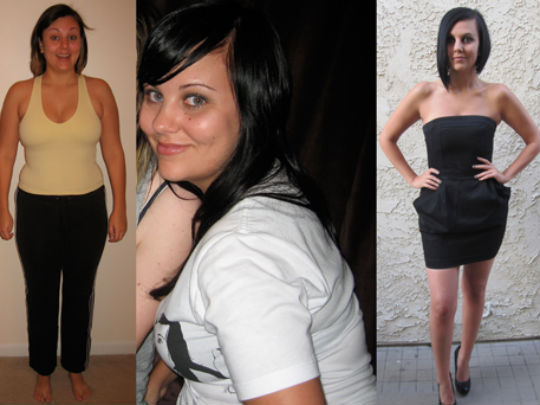
January 2007 smiling on the outside, 145 lbs; August 2008 and my highest weight when I first moved to Los Angeles, 155 lbs; May 2011 after figuring out what my body actually needs, a happy and healthy 125 lbs.
From age 15 to age 30 (I’m 31 years old now), I had been horrible to myself. I had put my body down, I had compared myself to others, and I had felt unworthy. I would declare my hatred for my hips while cramming a 100 Calorie Pack cupcake down my throat. I would curse myself for my lack of muscle while training for a marathon. If someone were to call me fat, tell me I was never going to be happy, or attempt to ruin my life, it would have been a no brainer to kick them out of my life—so why was I putting up with this kind of chatter from myself?
Once I realized I had been doing this, I literally hugged myself. I’m not kidding. I had a real moment with my mind, my soul, and this incredible body I was placed in. My intentions and values had previously been in all the wrong places, and these misguided feelings were turning me into a lesser version of who I truly am. I’ve discovered the joy of being unique, and how each and every one of us has a special message and purpose. With this understanding, everything I knew about diet, exercise, sleep, sun, and play became effortless for the first time. This is what life is all about.

Me at my current weight in 2014–and no more yo-yo dieting! I don’t weigh myself all that often now, because that number really means nothing to me. I’m healthier than I’ve ever been and that’s what matters the most. (Photo credit – Left: Jered Scott, Right: Calm Pictures and Ali Walker)
I’m not saying I’m perfect, that I’ve got it all figured out, or that I never slip back into old habits or thought processes—but when I do, I’m quickly able to recognize it and snap out of it.
I feel like my story isn’t unique, and that a lot of you—guys and gals of all ages and backgrounds—can relate to my life. I’m passionate about paying it forward, and hope that I can do so through Paleo Girl, my blog leslieklenke.com, and personal coaching (which will be available soon). If my message speaks to you, I would love to connect! In addition to my website, you can find me on: Instagram, Twitter, and Facebook.
Leslie
Learn More About the Brand New Book Paleo Girl and Grab Your Free Gifts While the Limited-Time Offer Lasts




Final 24 Hours of Paleo Girl Special Offer
 This is just a quick reminder that today is the final day of the special offer period for the newly released book Paleo Girl by Leslie Klenke. It ends at 11:59 PM PDT tonight, June 13.
This is just a quick reminder that today is the final day of the special offer period for the newly released book Paleo Girl by Leslie Klenke. It ends at 11:59 PM PDT tonight, June 13.
If you’ve been meaning to pick up a copy, but just haven’t gotten around to it yet, this is your last chance to grab a copy and get the free bonus gifts, including: a $10 gift certificate to PrimalBlueprint.com, a free eBook title Paleo Girl IRL, a signed copy of the book, and more.
You can learn all the details here.
And by the way, the audiobook version of Paleo Girl (pictured right) is now available on Amazon.com and Audible.com. Audiobook purchases count toward the special offer, so if you prefer listening to your books while on the go this is a great option for you.
If you already have the book in hand, Leslie, myself, and our entire team would be incredibly grateful if you would publish a review of the book on Amazon.com. Thank you in advance for your support. Grok on!




June 12, 2014
Do You Really Believe You Can Change?
 There’s something about an “against all odds” account that gets people going. I know I love them. I’m a sucker for a good sports tribute or even a good story that circulates on Facebook. Being in the field I’m in, I’ve seen it thousands of times. Heck, look through the MDA Success Stories and see how many are those jaw-dropping surprises you wouldn’t believe except you’re seeing it there in full pixel glory. Behind every one of those accounts is some kind of energy. It’s not unique. It’s just persistent. It’s a belief that you can leave behind old behavior and restriction. It’s a belief that you can walk into a new way of living the same way anyone else can. It’s the belief that you have what it takes to show up for yourself on a daily basis, accomplish the task you’ve set out to do and let the momentum take you to levels of health you desperately want or maybe can’t even envision yet. It’s the concept of self-efficacy.
There’s something about an “against all odds” account that gets people going. I know I love them. I’m a sucker for a good sports tribute or even a good story that circulates on Facebook. Being in the field I’m in, I’ve seen it thousands of times. Heck, look through the MDA Success Stories and see how many are those jaw-dropping surprises you wouldn’t believe except you’re seeing it there in full pixel glory. Behind every one of those accounts is some kind of energy. It’s not unique. It’s just persistent. It’s a belief that you can leave behind old behavior and restriction. It’s a belief that you can walk into a new way of living the same way anyone else can. It’s the belief that you have what it takes to show up for yourself on a daily basis, accomplish the task you’ve set out to do and let the momentum take you to levels of health you desperately want or maybe can’t even envision yet. It’s the concept of self-efficacy.
Research consistently confirms that our sense of self-efficacy will predict short-term and long-term success in behavior change. In other words, if we believe we can make a change, we’re much more likely to actually have success in making change happen. If under the facade of wanting change, however, we ultimately feel we’re incapable of accepting or sticking to the necessary behaviors, we’re sabotaging ourselves from the start.
The concept of self-efficacy was defined by the famous psychologist Albert Bandura in 1986. In a seminal article from that same year, a group of researchers applied the concept of self-efficacy to health behavior, separating it into two parts, namely our “outcome expectations,” the “expectations about the outcomes that will result from one’s engaging in a behavior” and our “efficacy expectations,” the “expectations about one’s ability to engage in or execute the behavior.” Outcome expectations can come into play we can get stuck in thinking, as the researchers suggest, that nothing – not even the most extensive and smart lifestyle change – will help us stave off a disease we fully expect to get, like inheriting our parents’ diabetes or high blood pressure. Unfortunately, in the nearly three decades since this seminal article, I’d say the fatalistic mindset has more of a collective impact than ever. Culturally, we’ve come to believe that disease is normal. We should fully anticipate developing one or more significant health conditions as we approach old age if not middle age. Too many people these days resign themselves to a life of ill health chalking it up to “aging.”
That said, it’s the self-efficacy expectations that undermine most of us. We don’t have a problem believing that living Primally will help us lose the weight, gain the energy, build the physical strength and stamina, and achieve great health as it’s done for so many. Beyond the confidence in the approach, however, we wonder if we ourselves will really be able to hack it – to follow through on all the dietary, exercise and lifestyle changes we want to make. At the end of the day, there’s this nagging old voice in the back of our minds asking if we really have it in us to thrive. Is that kind of success really for us to experience, or do we on some half-conscious level believe thriving is for “other people”? Will we end up dropping our better expectations for ourselves or curtailing our goals in lieu of “more reasonable” objectives that diminish the benefits we allow ourselves to experience? How far will our personal sense of self-efficacy take us? Where do we hit the end of the line – our (too often) self-imposed limitations?
Let’s jump ahead for a moment. The takeaways from self-efficacy research as it applies to health behavior suggest a number of points. First off, we’re generally better off thinking along the lines of a mastery “succession” that takes new behaviors through stages. This is especially important for those who are the types to hurl themselves into the pool, taking on every massive change at once only to get burned out quickly or caught off guard by influences/choices we can’t handle yet. Yes, it can work to accept multiple changes simultaneously, but expecting mastery right away in all of them is a setup for major frustration. Self-efficacy shifts based on a number of factors, including “magnitude,” which reflects the varying levels of difficulty. We can feel a sense of self-efficacy for the early level(s) of an endeavor but not feel it for higher levels of difficulty. Personal experience over time – in addition to the model of others’ successes and verbal encouragement – can convince us later to feel self-efficacy for these further, more advanced demands.
Likewise, the researchers suggest, we need to view our “lapses” through a more productive lens. Instead of throwing the baby out with the bathwater, we can choose to assess what influenced the detour. It’s that core Primal concept of “no failure – only feedback.”
What hits the nail on the head for me about self-efficacy research are the parameters often assigned to the definition itself: self-efficacy for a particular task at a particular time. Well, we can say self-efficacy for changing health, but in truth we need to get more specific. What is the particular task we’re trying to accomplish? What is the particular time in which we’re attempting to live the behavior change? I can’t tell you how many people I’ve worked with who completely trip themselves up on the fact that they can’t see themselves as the svelte man/woman at the beach. Likewise, they’ll say they can’t look into the future and see themselves as people who run 10Ks or who can lift what other people at the gym. They can’t envision doing five years from now what they can barely motivate themselves to do now. They’ll never lose the weight. They’ll never feel energetic the way they used to.
Therein lies the vast majority of self-efficacy issues in my mind. The beach bod example isn’t the behavior change itself. That’s self-image. If you’re wrapped around self-image and can’t extricate yourself from the negative messaging, you’ll never get to self-efficacy. The “I’ll never” statements? Those are the old stories we tell ourselves – old self-concept we need to let go of in order to assess our present reality rather than be stuck in a distorted perception that imposes its story on everything. Sure, you could call it generalizing poor self-efficacy. How about we just call it horse (blank)? Extract the all-consuming fiction from momentary fact. You’re able-bodied. You have a kitchen and money to buy food. There’s no place for “I’ll never” in this equation. Fluff – falsehood to be ejected from any further thinking. Likewise, squinting at “the future” and not seeing the ability to keep exercising is irrelevant. You aren’t making a commitment to be exercising five years from now. Who can commit to doing anything five years from now?
Self-efficacy is about your perception of your ability to complete a task – not to become a different person. Neither is it a blanket statement about your character or ability to take on any and all change. It’s about a particular change at a specific time. We live life, after all, in the particulars, in the day to day. Can I eat an omelet instead of Frosted Flakes for breakfast? Can I do 20 minutes of body weight exercise over the lunch hour? Can I get to bed by ten o’clock tonight? That’s really all that matters. When we focus on our capacity for the task, it depersonalizes the process. Suddenly, our baggage can’t rear its ugly head to manipulate or justify. Those negative, self-defeating storylines feed off of vagueness – the collapsing of past into distant future. They lose their intimidating dimensions in the present day.
Research aside now, I’ve said before that who you are tomorrow will decide what you’re capable of tomorrow. Your job is simply to decide today based on who you are and what you’re ready for today. That’s it. None of us can make judgments about ourselves five years from now or even five weeks from now. I’d argue that five days from now is irrelevant. It’s literally today. What can you believe you’re capable of accomplishing today? Scale it down to Grok scope. Yes, there was a sense of larger patterns, but life was lived in the action of the present moment.
I think of those parenting suggestions you read now about how to give your children confidence. Naturally, the younger generation is on my mind this week with the release of Primal Girl. The experts agree that we don’t foster confidence in our children – whether preschoolers or adolescents – by assigning descriptives to them: “Oh, you’re so smart,” “You’re great at sports,” “You’re a natural leader,” “You’re beautiful and healthy,” blah, blah. Offering them blanket statements imposes blanket truths they can’t possibly live up to all the time. From there, the dissonance inevitably confuses and possibly derails them. The better way is to praise their effort, to note their dedication, to celebrate the time and passion they put into their endeavors.
Funny how what works for the young’uns still works for the older folks. I’d argue we do ourselves a disservice when we trump up self-efficacy as a larger than life confidence or even swagger to achieve whatever we can envision. The truth is, we can build our own sense of self-efficacy by witnessing the evidence of our own dedication to the tasks we set for ourselves. The question isn’t so much “Can I achieve this?” as much as it is “Can I show up for this?” It’s an inquiry into both willingness and readiness. What’s blocking either or both of those elements?
Finally, I’d suggest that self-efficacy is a commitment to self-knowledge and even self-experimentation (you know I’m fond of that). When we choose to get healthy, to get strong, to feel better throughout our day, to enhance our life and longevity, we’re not really signing up for living by a particular formula. Formulas are like “diets”: they’re not sustainable in the long-run. I see self-efficacy as a dynamic force that requires continual investment, that has to respond, live and breathe in the present. There’s no settling for abstractions or living off your laurels. It’s about having the courage and determination to show up for real-time self-discovery. What do you need to let go of to feel up to a task? What influences, messages, people? What positive inputs do you require to maintain the perception of your capacity? We can cultivate true self-efficacy by focusing on the task but appreciating the dimensions of our process in getting there.
Thanks for reading, everyone. What thoughts does the subject bring up for you? How do you invest in your own self-efficacy, and how do you benefit? Share your feedback, and have a great end to the week.
Get the 7-Day Course on the Primal Blueprint Fundamentals for Lifelong Health Delivered to Your Inbox for FREE




June 11, 2014
An Open Letter to Kids and Teens (and Infant Prodigies)
In light of the recent release of Paleo Girl – a new Primal book that helps teens navigate the crazy world of flawed dietary and fitness advice, and get a jump start on healthy living – I’m republishing this article I originally wrote and published in December 2011. If you want the next generation to grow up in a healthier world, share this article with your friends and family. Let’s give the young adults in our lives the knowledge they need to be successful!
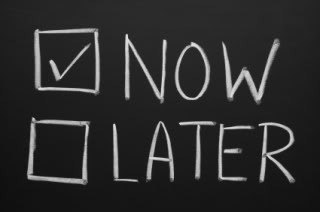 Dear youngsters,
Dear youngsters,
You’re going through some difficult times, no doubt. I’ve been in your shoes before. I’ve been a kid dealing with basically all the same stuff you have to contend with. I’ve been there.
Your hormones are probably (depending on age, gender, and exposure to attractive members of opposite/same sex) either raging, simmering, fomenting, budding, and/or swelling.
Your legs and arms may be growing at disproportionate rates, leaving you feeling like a stranger in your own body.
That cute new guy whom you planned on eventually marrying has a funny last name, which just won’t work with the names of the kids you’ve chosen.
You just discovered the Beatles, and you totally want to tell everyone about it, but they’re all into top 40 stuff. You just can’t relate.
Your opinions on everything, who your best friends are, your relationship with your parents, and your post-high school plans change rapidly from day to day to day. And not superficial changes, but real, soul-rending ones.
Everything’s in flux, but (or ergo?) everything’s exciting. Everything’s the end of the world, or the start of something new and magnificent. In short, you’re young, the world is big, and you want to make the most of it all.
But I have a suggestion for you. It’s a suggestion that I wish I would have read on a computer somewhere when I was a kid (of course, that would have required me waiting an hour for Al Gore to patch me through on the ARPANET on a computer the size of a room):
Consider going Primal. Don’t wait until you’re old, hurting, and full of regrets to seize control of your health. Take it from someone who did wait until he was old(er) and hurting to conquer his health issues. You don’t want to wait. If you do, you’ll still likely make it, but you’ll miss out on valuable time.
I’m not even going to say you have to go 100% hardcore Primal - although it certainly wouldn’t hurt. I’m just saying it would be a fantastic idea for you to become aware of this stuff while you’re still young and on the cusp of the prime of your life.
Are you a teen who wants to be strong, fit, and healthy for the rest of your life? Read this: http://ctt.ec/EP9L0+

The way I see it, if you don’t, you’re squandering a golden opportunity to extend the prime of your life through, well, the rest of it. Right now, I feel like I’m at my best. I honestly do. Mentally, emotionally, physically, professionally, I’m at a place where I wouldn’t trade places with myself 20 years ago. I was fit, doing triathlons, coming off of a strong career as a marathoner, but I was missing true health. Thanks to going Primal, I’m better than ever.
Now, think of what I just said. I’m 58. I’m probably older than your dad. I’ve lived over half a century, and yet I can:
Keep up with guys younger than half my age in high intensity Ultimate Frisbee.
Hike for twelve hours on an empty stomach.
Produce pretty decent content for a popular blog on a daily basis.
Write books and develop supplement lines that people actually buy and seem to really like.
Pass incredible quality time with my beautiful wife whenever I want.
Take a day off just to relax with the family if I so desire.
Spend half the day stand up paddle boarding.
Take my shirt off without feeling self conscious about my sagging gut and man-boobs.
Bound up flights of stairs because it’s easier and less time consuming than walking up them and scoff at escalators.
Feel mentally “there” and “on” at all times (okay, maybe the morning coffee helps in this regard, sometimes).
The thing is, these aren’t magical or fantastical accomplishments. I think these are extremely basic things any human should be able to expect out of themselves, albeit with minor variations. Not everyone is going to blog or play Ultimate, but everyone should be able to find creative satisfaction and engage in physical activity whenever they want without worrying out getting injured, something hurting, or fatiguing too quickly.
And I’m just some old dude who made a ton of mistakes early on and paid dearly for them… and I’m still doing pretty darn good. I’m not the only one, either. Many, if not most, of our success stories on this blog come from people who came back – better than ever – from poor health caused by making the wrong choices based on the wrong information in their younger years. Learn from their and from my mistakes so you don’t have to make them yourself.
Just imagine where you’ll be at 58 if you stay abreast of this health and fitness and nutrition and stress stuff starting from an early age. Just imagine how ahead of the game you’ll be, and stay for as long as you want.
Honestly, though? There’s a little selfishness going on here, too. I’m convinced that the earlier you commit to a Primal lifestyle, the greater the rewards later on in life, and I really want to see it happen. I know we’re never going to get anything close to a big study on the Primal lifestyle funded to test this idea out, but if we can convince a host of youngsters to start young – and stick with it – I think we’d see some remarkable things happen.
No, I’m not talking about forging Olympians or NBA stars or anything like that, necessarily. I’m referring to the promotion of a generation of healthy, happy, robust, fit, attractive, and most importantly of all, self-sufficient people forging their own paths toward health and wellness. I’m imagining a world where doctors flourish as the skilled technicians they are, meeting acute challenges without having to focus so much on the chronic stuff that they’re often unprepared to handle and their patients are unwilling to handle. Where people take responsibility for their own health, and it’s not a struggle or an ordeal, but rather just second nature. Heck, maybe it’ll even be a generation for whom this Primal stuff isn’t so crazy at all.
So, teens, tots, children, whoever (heck, even parents) – give it an honest shot. You don’t have to give up hanging out with friends or even grabbing pizza after a game sometimes. Embrace the 80/20 principle and just learn to make the right choices most of the time and understand that humans don’t come broken out of the box. That even though observing the greater population at large might lead you to the opposite conclusion, people are by and large born primed for excellent health.
Now go. Get healthy while you’re still healthy, while you’re still unbroken. It’s always easier – and more effective – to keep a new knife sharp than to restore a chipped, rusty, neglected old one.
Thanks for reading, everyone, and please share your advice with the younger amongst us in the comment board below.
Learn More About the Brand New Book Paleo Girl and Grab Your Free Gifts While the Limited-Time Offer Lasts




Mark Sisson's Blog
- Mark Sisson's profile
- 199 followers




